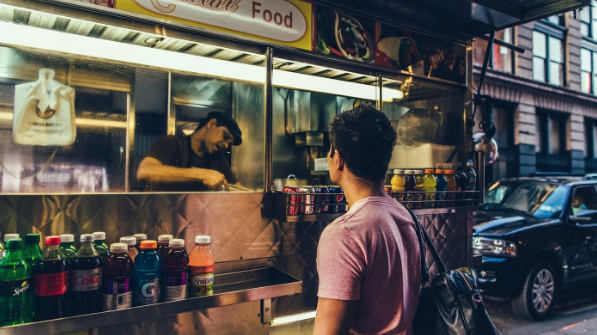Warning: Undefined array key "sharing_networks_networks_sorting" in /var/www/wp-content/plugins/monarch/monarch.php on line 3904
Warning: Trying to access array offset on value of type null in /var/www/wp-content/plugins/monarch/monarch.php on line 3904
With city ordinances making it hard for consumers to visit indoor bars and restaurants, many people thought that the Big Apple’s world-famous culinary scene was dead. Mayor de Blasio’s policies have had an unforeseen side-effect, however. Since consumers haven’t been able to eat in their favorite dining rooms, they’ve been visiting food trucks in droves.
A proposed New York City tax law could tip the scales even more in the favor of food truck operators. All goods delivered to your door could be slammed with a convenience tax of 3 percent. Consumers who are accustomed to ordering out for delivery might soon start walking to the truck on the corner instead.
Small businesses are already prepared for the rush.
Revamping a Food Truck to Deal with Demand
Due in no small part to the pandemic and New York’s already onerous health code, an overwhelming majority of food truck upgrades have been related to cleanliness. Plastic partitions that divide patrons and servers have become commonplace throughout the city and contactless payments have become all but mandatory in many cases. The national coin shortage hasn’t exactly helped, either. Fortunately, small business owners have found that investing in an affordable food truck point of sale system has helped to take much of the guesswork out of making these needed upgrades.
Once they have a new digital POS up and running, they’re free to accept credit and debit cards as well as more esoteric forms of payment. Few people would have ever thought that consumers would have wanted to pay for their food with cryptocurrency tokens, but a growing percentage of diners actually do. Payment processors have made it easy to sign up for these services by offering subscription plans based on a small flat fee. This has proven affordable even to food truck operators who’ve been dealing with supply problems and rising costs.
One thing they haven’t run into, however, is decreased demand. In some cases, people have started to eat more frequently at food trucks than they ever have before. World events have once more played into this saga, but not in the way you might think.
Feeding Protesters & Donors
When protesters took to the streets of New York, some cagey food truck operators found a way to make a quick buck. Culinary activists from the Bronx learned that protesters have to eat just like anyone else, and they were able to make enough money that they could support several local charities. One of these charitable groups actually refurbished old postal vans into food trucks, which were then used to distribute food to those in need.
In turn, this created a growing trend of food truck-based fundraisers where donors are able to get something to eat while they support a good cause. Though menus might look a little more sparse than they did in previous years, it seems like many people don’t really care. They’re more than happy to find a place still selling hot meals in the midst of a shutdown.
You may remember when white asparagus became something of a fad in the Manhattan area. Food truck operators often can’t get these kinds of exotic ingredients any longer.
In spite of that, short-order cooks have found new ways to jazz up old favorites. Countless varieties of hot dogs have been invented in the last few months and new recipes are coming into existence all the time.
Many of these will probably stay on food truck menus even after indoor restaurants return to full capacity.
The Future of New York’s Food Trucks
Obviously, customers who are only patronizing food trucks because their favorite restaurants aren’t open may gravitate toward other businesses in the future. Some of them will probably keep visiting their new favorite mobile eateries, however, and that bodes well for the food truck industry as a whole.
If people don’t feel comfortable returning to indoor dining areas, then the future might even be brighter for food truck operators. Seasonal vendor licenses are available for those who want to run a temporary mobile restaurant from April 1 through October 31 of each year. It’s likely that many entrepreneurs are likely to apply for this kind of a permit to test the waters next year and see how many of their new clients stick around.
Others may try to start serving local favorites as soon as businesses start to open up. Judging by an interview with a local chef, there’s still quite a large demand for classic New York-style bagels and bialys. Truck operators who aren’t currently able to get enough AP flour and kosher onions to make baked goods like these will be certain to sell them in droves once they’re able to put them back on their menus.
No matter what next year’s economic outlook is like, food truck operators should still be a common sight in all five boroughs.

